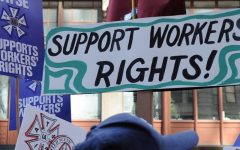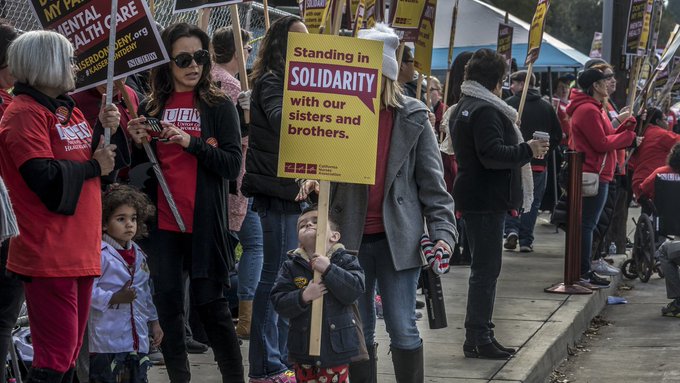
Albertson's supermarket grocery store, Goleta, CA. (Photo: Lisa Aiken, Shutterstock)
Possible So Cal Grocery Strike Harkens Former Employees Back to 2003-2004 Strike
The weakened unions won back some of their healthcare and got some concessions
By Evan Symon, March 30, 2022 6:55 am
The United Food and Commercial Workers International Union (UFCW) and four Southern California grocery stores, consisting of Ralphs, Albertsons, Pavilions, and Vons, inched closer to a strike on Monday following a vote by union members saying that they are willing to strike if their demands are not met soon. Workers are demanding up to $5 an hour more for employees, more health and safety commitments from the stores, as well as more hours for the part-time workers. The parent companies of the stores, Kroger and Albertsons, meanwhile, have only offered a 60 cent raise, noting that thin profit margins and the cost of running stores in Southern California are major factors working against demands, although they have said that they would continue healthcare.
To many, this would be their first strike. But to many long-time employees, and some looking to be replacement employees this time around, it wouldn’t be the first. There was a far uglier strike years before in 2003-2004.
In 2003, companies facing higher costs and more competition from the growing number of big box stores such as Wal-Mart, reduced healthcare and other benefits for employees to stay cost effective. The UFCW and UNITE HERE unions fired back that employees couldn’t pay for over $1 billion in suddenly shifted healthcare costs. Talks quickly broke down, and on October 11th, almost 70,000 grocery store employees went on strike.
“It was both exhilarating and scary,” said Jose Salazar, then a Ralph’s employee at a Los Angeles store, to the Globe on Tuesday. “There was this wave of what we were doing was right and that we would get our healthcare back, and get paid more, and then go to Costco and Wal-Mart and get them unionized. But it was scary too. Cost of living in LA was bad too back then, and many employees knew they would struggle to find a better paying job elsewhere because, for a lot of Latinos back then who came over here, hiring options were more limited. Remember, this was a time when border issues started becoming a huge deal post 9/11, and those that were undocumented, or only had green cards, were worried.”
“Still, we thought we were going to win it.”
Union members went on the picket line at stores across Southern California. With around 900 stores affected, many customers were refusing to cross the lines due to the strong labor union core in California. Over the next few months, chains were losing hundreds of millions, with customers going to Costco, Trader Joe’s and other chains not striking instead. When stores were rushed for Thanksgiving, not much was to be found. For strikers, this was mixed.
“We were happy they were supporting us, but we saw on the news that many were heading to Wal-Mart and other non-unionized stores,” said ‘Angie’ a current employee at one of the stores who was working there in 2003. “We contacted several papers and told them that, basically, head to unionized stores instead.”
Former Vons worker Gary Mahone added that “It was cold out there picketing. We had police watching us too. We blocked cars when crossing the sidewalk by walking slowly for as long as we possibly could to deter people from going in. We said ‘You’re killing us!’ when they drove in instead. But by and large it was working. At 6 P.M., usually when it’s filled with people picking something up on the way to work, the parking lot was a ghost town. We heard the same from other strikers. 2003 was the year of the cell phone to many of us because we used them to coordinate and share info so much.”
“Everyday we heard stories that they were going to cave,” noted Salazar. “Victory was right there. Then came the wildfires and the holidays.”
The 2003 Firestorm
In late 2003, 14 different wildfires swung through Southern California in what was known as the “2003 Firestorm.” This included California’s largest fire to date, the Cedar Fire, and the Old Fire, which was large enough to alter how firefighters went about fighting wildfires. The Cedar Fire alone caused $1.3 billion in damages, caused the deaths of over a dozen people and threatened large parts of San Diego County. Panicked people across SoCal rushed to stores, with many originally respecting the strike by going past them to get food and supplies. And by the time the fire ended, many more kept breaking the strike to get ready for the holidays.
“I’ll never forget one woman,” said Salazar. “She was a Professor at the University. Always on TV for liberal causes and marches. That year she had even been arrested for an anti-war march I think. She would come by in the early weeks giving us water and cheering us on, and getting her picture taken with us. Then, when the wildfires hit, and we had people going past us, we all saw her wordlessly drive her car in, go into the store, and come out with bags of groceries. A few of us called out to her, but she didn’t even look at us. Like most people, they were for us, but when they were facing a crisis of their own, they abandoned us.”
“We screamed out to them going in that we had kids who needed us,” said Sherry, a San Diego store worker, to the Globe. “They screamed back ‘So do I.’ It was an emergency for both of us, but fire beats oppressed worker. And a fire would have been nice because it was really cold that winter.”
Mahone also noted that “The fires died down by November, and you know, some went back to staying out, most thought that bell was already rung so they went in for Thanksgiving and Christmas and New Years and the Super Bowl. October had been great, but seeing the strike break down before our very eyes? That was tough.”
The end of the strike, parallels to 2022
In February 2004, the unions and the companies hammered out a settlement. The weakened unions won back some of their healthcare and got some concessions like a combined pension fund and wage contracts for the first and third years of employment. However, the companies got much more than they could have hoped, with all future employees getting no personal days, lowered salaries, lower holiday pay, longer vacation time off accumulation, and basically a longer time for most things.
“We screwed everyone following us over,” said Salazar. “You can try and say something around it, but that’s what we did. I worked there for only another two years before I got my degree, and every employee that was hired on after us kinda hated us for doing that to them. Most were younger too who didn’t care about healthcare. We’d say ‘We saved your healthcare!’ but they would say back ‘I can’t afford rent because of you.’ It was ugly.”
Angie noted that “We said that we won, but we really didn’t. The union said it was a victory, but it didn’t feel like one. We had just spun the wheels in the mud, moved up an inch, and splashed mud at the car behind us. My son said that to me not long after the strike ended, and at first I hated that analogy, but now, it’s very fitting.”
Other incidents, like Ralphs having to pay $70 million because they had hired replacement workers with encouraged fake names and social security numbers, added to the frustration of the union. Near strikes in 2011 and 2019 brought back memories for many. But with a 2022 strike looking more and more likely, may former and current workers who were a part of the 2003-2004 strike said that although the times have changed, and some of the reasons for striking are different, it can still end in a way that companies and unions can’t imagine.
“We were done in by fires and customers’ growing apathy for us,” Salazar added. “This time, they need to be more strategic and adapt to unusual circumstances. We kept the same tactics when the wildfires happened and during Christmas. We didn’t get past their panic. Strikers today need to prepare for that and counter it. Anyone, especially in California, can say they’re a liberal. But once those fires start or they’re threatened, those beliefs go right out the window. We saw that during the pandemic where vegans were buying whatever food they could in stores during those food run months and people who talked about buying sustainable products fighting over toilet paper. If they strike they have to prepare for people getting apathetic like that.”
- Bill to Require Law Enforcement Disclosure if AI Was Used To Help Write Reports - August 7, 2025
- Gov. Newsom Files FOIA Request To ‘Expose True Cost’ Of L.A. Federal Troop Deployment for Anti-ICE Riots - August 6, 2025
- California Redistricting: How Newsom’s Plan Will Demolish Hard Fought GOP Gains - August 6, 2025





“I’ll never forget one woman,” said Salazar. “She was a Professor at the University. Always on TV for liberal causes and marches. That year she had even been arrested for an anti-war march I think. She would come by in the early weeks giving us water and cheering us on, and getting her picture taken with us. Then, when the wildfires hit, and we had people going past us, we all saw her wordlessly drive her car in, go into the store, and come out with bags of groceries. A few of us called out to her, but she didn’t even look at us. Like most people, they were for us, but when they were facing a crisis of their own, they abandoned us.”
Perfect example of a pathetic leftist coward. These are the same people who would abandon the USA and move to a different country if we were attacked like Ukraine. Their devotion to “the cause” only goes as far as their self-interest and comfort will allow. The strikers should have grabbed her and made her stand there with them with a strike sign. I am totally supportive of the Ukrainian president requiring ALL eligible biological males to stay in-country and fight the Russians.